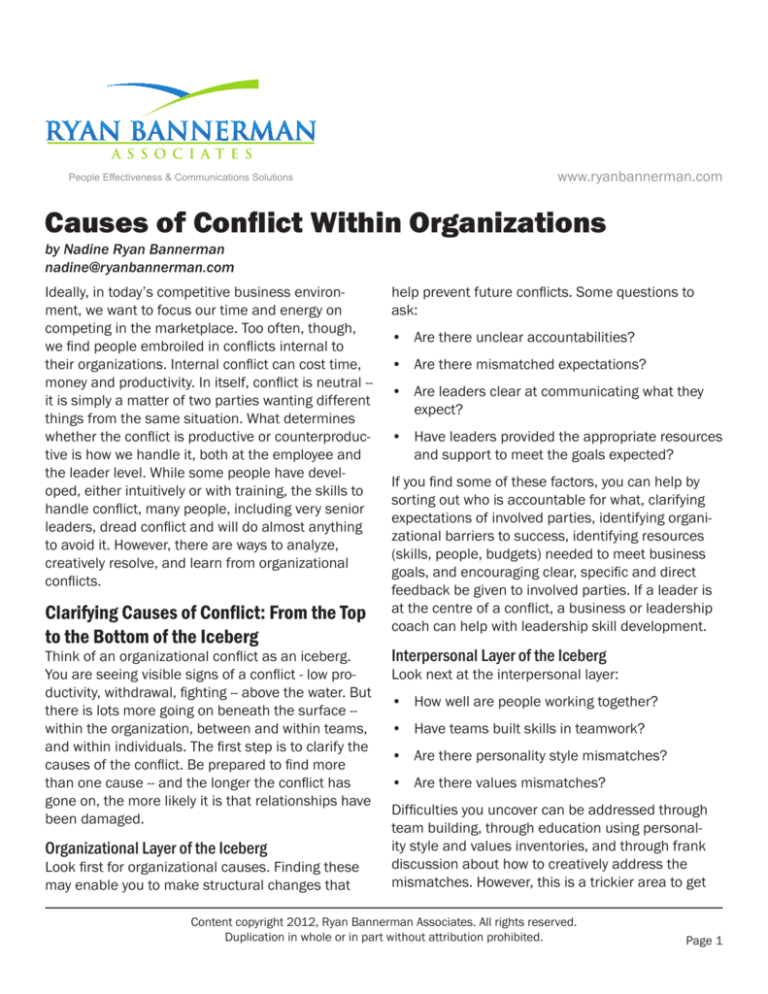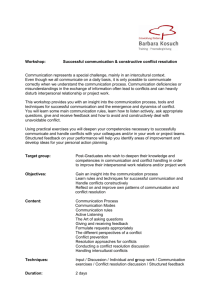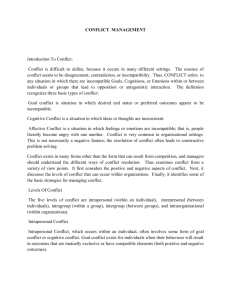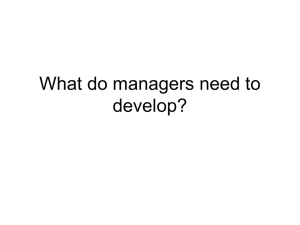
People Effectiveness & Communications Solutions
www.ryanbannerman.com
Causes of Conflict Within Organizations
by Nadine Ryan Bannerman
nadine@ryanbannerman.com
Ideally, in today’s competitive business environment, we want to focus our time and energy on
competing in the marketplace. Too often, though,
we find people embroiled in conflicts internal to
their organizations. Internal conflict can cost time,
money and productivity. In itself, conflict is neutral -it is simply a matter of two parties wanting different
things from the same situation. What determines
whether the conflict is productive or counterproductive is how we handle it, both at the employee and
the leader level. While some people have developed, either intuitively or with training, the skills to
handle conflict, many people, including very senior
leaders, dread conflict and will do almost anything
to avoid it. However, there are ways to analyze,
creatively resolve, and learn from organizational
conflicts.
Clarifying Causes of Conflict: From the Top
to the Bottom of the Iceberg
Think of an organizational conflict as an iceberg.
You are seeing visible signs of a conflict - low productivity, withdrawal, fighting -- above the water. But
there is lots more going on beneath the surface -within the organization, between and within teams,
and within individuals. The first step is to clarify the
causes of the conflict. Be prepared to find more
than one cause -- and the longer the conflict has
gone on, the more likely it is that relationships have
been damaged.
Organizational Layer of the Iceberg
Look first for organizational causes. Finding these
may enable you to make structural changes that
help prevent future conflicts. Some questions to
ask:
• Are there unclear accountabilities?
• Are there mismatched expectations?
• Are leaders clear at communicating what they
expect?
• Have leaders provided the appropriate resources
and support to meet the goals expected?
If you find some of these factors, you can help by
sorting out who is accountable for what, clarifying
expectations of involved parties, identifying organizational barriers to success, identifying resources
(skills, people, budgets) needed to meet business
goals, and encouraging clear, specific and direct
feedback be given to involved parties. If a leader is
at the centre of a conflict, a business or leadership
coach can help with leadership skill development.
Interpersonal Layer of the Iceberg
Look next at the interpersonal layer:
• How well are people working together?
• Have teams built skills in teamwork?
• Are there personality style mismatches?
• Are there values mismatches?
Difficulties you uncover can be addressed through
team building, through education using personality style and values inventories, and through frank
discussion about how to creatively address the
mismatches. However, this is a trickier area to get
Content copyright 2012, Ryan Bannerman Associates. All rights reserved.
Duplication in whole or in part without attribution prohibited.
Page 1
People Effectiveness & Communications Solutions
involved in and there are times when the relationship has deteriorated so much, and the mismatches
are so great, that the interpersonal level of conflict
cannot be resolved. In this case, the organization
has to make some choices: if it is a large enough
organization, people can be transferred to other areas, if not, someone may no longer be able to work
effectively in that organization.
www.ryanbannerman.com
methods of achieving positive business results.
Please see table next page.
Individual Layer of the Iceberg
The final place to look for the cause of conflict is in
the individual or intrapersonal layer. Frequently, conflicts are written off as a problem with an individual.
If, however, you first assume that an individual is the
cause of a conflict before you do the organizational
analysis, you may miss the structural factors such
as inadequate hiring, promotion, and training procedures. Addressing these structural inadequacies
can add lasting value to your organization. When
all of the analysis has been done, you may find that
a person is in the wrong job, or has mismatched
skills, values, and attitudes for the organization.
Training, skill development, coaching, career counselling and other tools may help when a clear cause
of the conflict is at the individual layer.
Putting It All Together
Conflicts in organizations can be complex to sort
out; as you go further down each layer of the iceberg, you find deeper issues to resolve. Yet by following a systematic clarification process, you can uncover organizational causes that can be addressed
creatively to prevent future non-productive conflicts
from occurring. Effective learning can result for all
of the people involved, including the ability to spot
a non-productive conflict early and turn it into a productive one that will help develop improved
Content copyright 2012, Ryan Bannerman Associates. All rights reserved.
Duplication in whole or in part without attribution prohibited.
Page 2
www.ryanbannerman.com
People Effectiveness & Communications Solutions
Causes of conflict
Tools & methods to help
Unclear accountabilities
RACI charts, accountability agreements, role descriptions
Expectation changes
Feedback and coaching to leader
Feedback and coaching to leader, remove organizational barriers, provide resources
Organizational
Organizational
Mismatched expectations
Leader communication of expectations
Resources and support inadequate to meet business goals
Interpersonal
Interpersonal
How well are people working together? Have teams
built skills in teamwork?
Are there personality style matches?
Values mismatches?
Teambuilding
Intrapersonal
Intrapersonal
Mismatched skills for job
Mismatched values for job/organization
Mismatched attitudes for job/organization
Training, skill development
Counselling, coaching, if mismatch not too great
Clear and specific feedback, coaching, if mismatch
not too great
Personality inventories, education, mediation
Values inventories, education, mediation. For values mismatches, there may not be a way to resolve,
depending on how great the mismatch
Content copyright 2012, Ryan Bannerman Associates. All rights reserved.
Duplication in whole or in part without attribution prohibited.
Page 3









